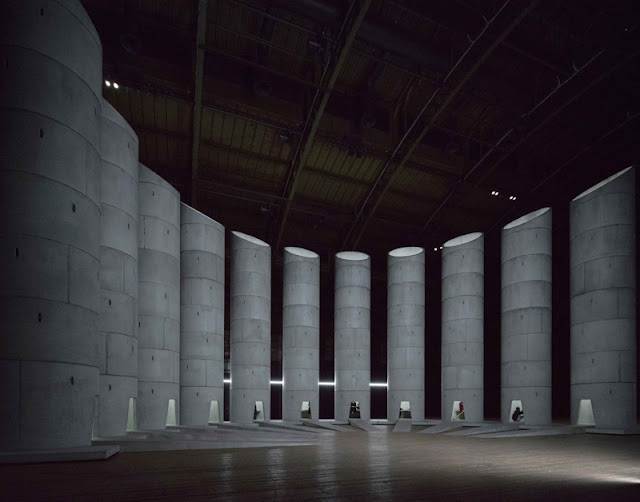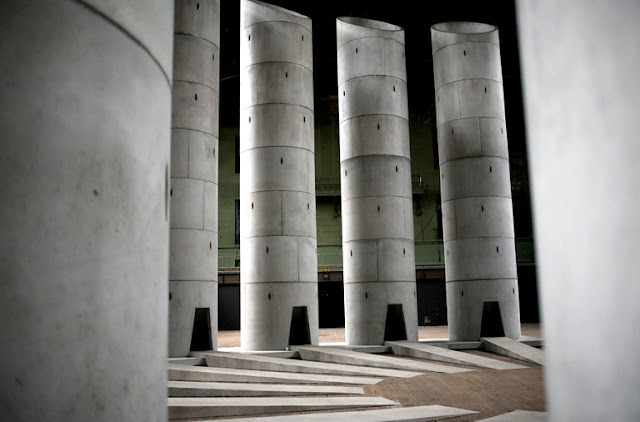
I surprise even myself in saying this. Let me explain. The Park Avenue’s huge, high 55,000-sq ft Wade Drill Hall space is filled with eleven 48ft tall colossal concrete silo-like towers which contain an assortment of 30 active, professional mourners from around 20 different countries like Armenia, Bhutan, Cambodia, Ghana, Ecuador, Colombia, China, Russia, Azerbaijan... all enacting their own funeral rites, tributes & lamentations in music and song, dirge and wailing.
So many cultures celebrating lost lives in various languages, with different instruments - horns, drums, cymbals, bells, gongs or flute - makes for a cacophony of sound. 

Visually breathtaking, emotionally challenging, physically demanding, (the darkness makes quick movement difficult) one is expected to absorb it all in 30 minutes! From start to finish. And the ending is somehow shocking too. A clanging noisy metal grill suddenly goes up & the audience is expelled from a womb-like sombre vigil onto crowded Lexington Avenue with its blaring taxis, grinding taxis & hordes of tourists.
One starts by climbing the Armory's long outside fire escape, entering the high balcony, descending a (specially built) staircase, and at last arriving on the floor.
The view from the balcony is breathtaking. All is silence; then slowly tiny black-clad figures emerge and disappear into the base of the concrete columns. One figure dressed in red - the monk from Bhutan - was a welcome tiny spot of colour.
The view from the balcony is breathtaking. All is silence; then slowly tiny black-clad figures emerge and disappear into the base of the concrete columns. One figure dressed in red - the monk from Bhutan - was a welcome tiny spot of colour.
It's a lot to take in, to digest.
I was also surprised by the close proximity of all the "action". The cylinders or silos are very tall but make for small little rooms, for me reminiscent of the base of medieval Scottish castle staircases which wind ever upwards. So 2 people - Ok. Four is a crowd. The doorway is very low, so visitors must stoop, (I assume these enclosures aim to contain the sound a little). I was hesitant to enter. It seemed all wrong to barge in on such a solemn ritual - but New Yorkers were not so puritanical!
Rather like shoppers at Saks they rushed around, in and out, determined not to miss a thing (tickets start at $45 & are sold out!)
I began on the far right side where 3 musician mourners in white played exotic sounds. At the far left mourners were all in black, nearby a man from Ecuador in dark glasses played the accordion. Best by far in costume was the bird-headed, beaked, masked mourner from Burkino Faso, West Africa & the monks in red with their long gold horns ready for a 3 day festival.
Strangely we were only given programmes as we left - so we had no idea which nationality of mourner we were looking at or hearing as mostly the languages were unknown to us.
In fact the programme itself is intensely academic with masses of unnecessary historical detail from experts on the subject, plus copies of the visas some of the foreigners eventually gained (not all as some visa applications were refused.) No info on the actual performers at all. I would love to know - does the Albanian woman come from a long line of mourners? Did her mother do it professionally? Were the Cambodians friends? Did they come from the same town or village? Were the Greek couple married? Related? I read that the Indian women must be married, over 35 & have kids over 15. What such rules are there in Malaysia or Venezuela ?
And why no exuberant Day of the Dead Mexicans ? (Visa problems?) or Scottish bagpipe lament to chill the spine. Why no Italian priests nor American Evangelists?
What Simon is really talking about are funerals - be they in remote hamlets, on distant hillsides, on Fifth Avenue or in St Paul's, the scenario is the same. The more mourners, the more expensive the trappings, the more important the deceased. And any ritual or ceremony helps people fill the dreadful void; get through the next days.
Families in Romania or Chicago, Ghana or China all try to pay for the best. In Cambodia if there is not enough money to hire the professional troupe, "they dig a grave, bury the body and then save up to invite a funeral music troupe later on." It will all make a good, if academic, book.
I also learned, from notes from Dr Kondi of Wittenberg Uni, Germany, that in Albania the "Funeral performance is composed of free crying & disciplined lamenting. .. The exchanged lamentation between Christian & Muslin women constitutes one of the unique features of the north-Albanian funeral ceremony." Praise be!
I also learned, from notes from Dr Kondi of Wittenberg Uni, Germany, that in Albania the "Funeral performance is composed of free crying & disciplined lamenting. .. The exchanged lamentation between Christian & Muslin women constitutes one of the unique features of the north-Albanian funeral ceremony." Praise be!
Back to the installation: so enormous, so solid, so expensive I am sure - made in collaboration with the architect Shohei Shigematsu of Rem Koolhaas's OMA (who was responsible for creating the recent stunning, celestial “Manus x Machina” show at the Met’s Costume Institute).
I will long remember this towering monolithic structure with chamfered tops so that - lit from inside- it glows in the very dark theatrical space. A sculptural installation stage set like no other: visually stunning, emotionally moving, frustratingly rushed - but NOT TO BE MISSED.











